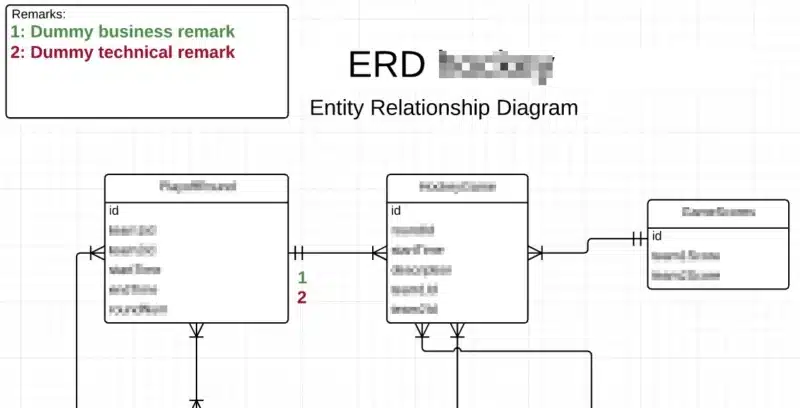


In Business Intelligence we extract data from anywhere. Beside the technical structures that define how the data is stored, we also need to comprehend the business processes behind that structure. It’s all in the name, right?
Figure 1 – The devil is in the details (made with Lucidchart)
If it was so easy to just extract the data from the source and load it directly into the data warehouse, BI analysts/developers would become obsolete. In a lot of cases the incoming data is transformed which entails extra business rules or logic being applied to obtain a final, correct, expanded data set that makes sense to the business user and offers a clear insight.
When a business rule isn’t translated properly into a technical transformation, this early error – that can be a small detail – made between analysis and development will cascade further and can have disastrous results. Defining this translation means communicating with the people involved at the technical and business level. This can mean meeting up, calling or in most cases mailing the persons involved. In my personal experience I’ve noticed that a visualization of a question/problem tends to be better understood by other people and involves them more effectively. A diagram is concise, more appealing and less prone to ambiguity which goes hand in hand with the KISS principle (Keep It Short and Simple). Remember nobody is waiting for that 100th mail of the day with pages of text.
Despite Lucidchart being a direct competitor of Microsofts’ Visio, which also offers extensive capabilities, this tool is cloud based which means you don’t have to install anything. Since in a lot of cases a workstation is provided by the customer, this shouldn’t be an obstruction anymore. You will have a cloud based working environment and a document repository at your disposal for free. These benefits made me choose Lucidchart above Visio. Free also means limited capabilities though:
But even with limited capabilities your options are still very diverse. The user interface is appealing, responsive and intuitive so you are started up quickly.
You will be able to import and export to Visio files. Although this is not a free feature, it’s nice to know that the tool offers this kind of extensibility.
Main benefits for me as an individual user:
Next I will explain two personal kinds of visualizations that recur from time to time.
Figure 2 –Timeline business case chart (made with Lucidchart)
A lot of times the business needs to involve time as a transformation parameter which in my eyes can become a maze fast. Especially if the business user himself is defining cases on the spot. In the image above you see the result of a first meeting with the business user. I have visualized 3 different cases based on a timeline (gray line), events (yellow rectangles) and contracts (green rectangles). Over a certain time period we have all kinds of events that can happen to a certain contract. The above image acted as a starting point. The visual representation enabled the business to think of new cases more easily: what if I drag a yellow rectangle after a green rectangle et cetera. Moreover this way we had common concepts based on colors: a timeline, an event and a contract. So we were always talking about the same things when communicating to each other. While this seems self-evident my experience teaches me that this is definitely not always the case.

Figure 3-ERD diagram (made with Lucidchart)
A lot of times you will be searching for the correct data when business requests have been defined. This means going to the technical person that has knowledge of the data source: an application developer, functional analyst et cetera. Sometimes this really can be a hassle because of the normalization of OLTP systems. You have your business definition that you can explain to the technical person and normally he should be able to point you in the right direction. But this isn’t sufficient, remember the devil is in the details.
In just a few situations I have been presented an ERD (Entity Relationship Diagram) while it makes all the difference. So especially in longer assignments I have tried to compose my own ERD’s for the source entities/tables. Sometimes it seems overkill to make an ERD for 3 entities, but from my own experience I have learned that with new business requests new tables will have to be migrated with or without additional transformations. After a year you may end up extracting data from 40 entities and then a good ERD will prove it’s worth acting as a blueprint to offer quick insight.
Do we have to visualize everything? Off course not, but when it is the most efficient way to explain complex problems, define business cases, dissect database structures et cetera in a visual way, don’t be afraid to try it out.
© 2023 Kohera
Crafted by
© 2022 Kohera
Crafted by
| Cookie | Duration | Description |
|---|---|---|
| ARRAffinity | session | ARRAffinity cookie is set by Azure app service, and allows the service to choose the right instance established by a user to deliver subsequent requests made by that user. |
| ARRAffinitySameSite | session | This cookie is set by Windows Azure cloud, and is used for load balancing to make sure the visitor page requests are routed to the same server in any browsing session. |
| cookielawinfo-checkbox-advertisement | 1 year | Set by the GDPR Cookie Consent plugin, this cookie records the user consent for the cookies in the "Advertisement" category. |
| cookielawinfo-checkbox-analytics | 11 months | This cookie is set by GDPR Cookie Consent plugin. The cookie is used to store the user consent for the cookies in the category "Analytics". |
| cookielawinfo-checkbox-functional | 11 months | The cookie is set by GDPR cookie consent to record the user consent for the cookies in the category "Functional". |
| cookielawinfo-checkbox-necessary | 11 months | This cookie is set by GDPR Cookie Consent plugin. The cookies is used to store the user consent for the cookies in the category "Necessary". |
| cookielawinfo-checkbox-others | 11 months | This cookie is set by GDPR Cookie Consent plugin. The cookie is used to store the user consent for the cookies in the category "Other. |
| cookielawinfo-checkbox-performance | 11 months | This cookie is set by GDPR Cookie Consent plugin. The cookie is used to store the user consent for the cookies in the category "Performance". |
| CookieLawInfoConsent | 1 year | CookieYes sets this cookie to record the default button state of the corresponding category and the status of CCPA. It works only in coordination with the primary cookie. |
| elementor | never | The website's WordPress theme uses this cookie. It allows the website owner to implement or change the website's content in real-time. |
| viewed_cookie_policy | 11 months | The cookie is set by the GDPR Cookie Consent plugin and is used to store whether or not user has consented to the use of cookies. It does not store any personal data. |
| Cookie | Duration | Description |
|---|---|---|
| __cf_bm | 30 minutes | Cloudflare set the cookie to support Cloudflare Bot Management. |
| pll_language | 1 year | Polylang sets this cookie to remember the language the user selects when returning to the website and get the language information when unavailable in another way. |
| Cookie | Duration | Description |
|---|---|---|
| _ga | 1 year 1 month 4 days | Google Analytics sets this cookie to calculate visitor, session and campaign data and track site usage for the site's analytics report. The cookie stores information anonymously and assigns a randomly generated number to recognise unique visitors. |
| _ga_* | 1 year 1 month 4 days | Google Analytics sets this cookie to store and count page views. |
| _gat_gtag_UA_* | 1 minute | Google Analytics sets this cookie to store a unique user ID. |
| _gid | 1 day | Google Analytics sets this cookie to store information on how visitors use a website while also creating an analytics report of the website's performance. Some of the collected data includes the number of visitors, their source, and the pages they visit anonymously. |
| ai_session | 30 minutes | This is a unique anonymous session identifier cookie set by Microsoft Application Insights software to gather statistical usage and telemetry data for apps built on the Azure cloud platform. |
| CONSENT | 2 years | YouTube sets this cookie via embedded YouTube videos and registers anonymous statistical data. |
| vuid | 1 year 1 month 4 days | Vimeo installs this cookie to collect tracking information by setting a unique ID to embed videos on the website. |
| Cookie | Duration | Description |
|---|---|---|
| ai_user | 1 year | Microsoft Azure sets this cookie as a unique user identifier cookie, enabling counting of the number of users accessing the application over time. |
| VISITOR_INFO1_LIVE | 5 months 27 days | YouTube sets this cookie to measure bandwidth, determining whether the user gets the new or old player interface. |
| YSC | session | Youtube sets this cookie to track the views of embedded videos on Youtube pages. |
| yt-remote-connected-devices | never | YouTube sets this cookie to store the user's video preferences using embedded YouTube videos. |
| yt-remote-device-id | never | YouTube sets this cookie to store the user's video preferences using embedded YouTube videos. |
| yt.innertube::nextId | never | YouTube sets this cookie to register a unique ID to store data on what videos from YouTube the user has seen. |
| yt.innertube::requests | never | YouTube sets this cookie to register a unique ID to store data on what videos from YouTube the user has seen. |
| Cookie | Duration | Description |
|---|---|---|
| WFESessionId | session | No description available. |